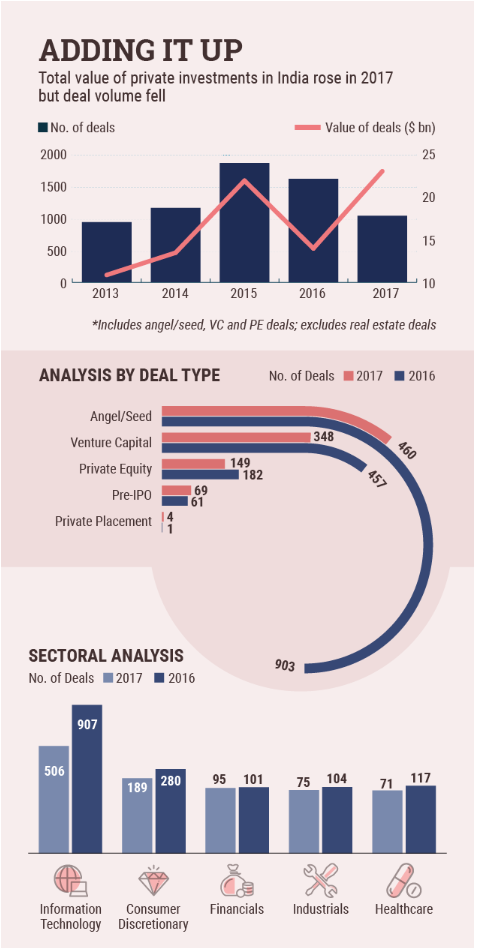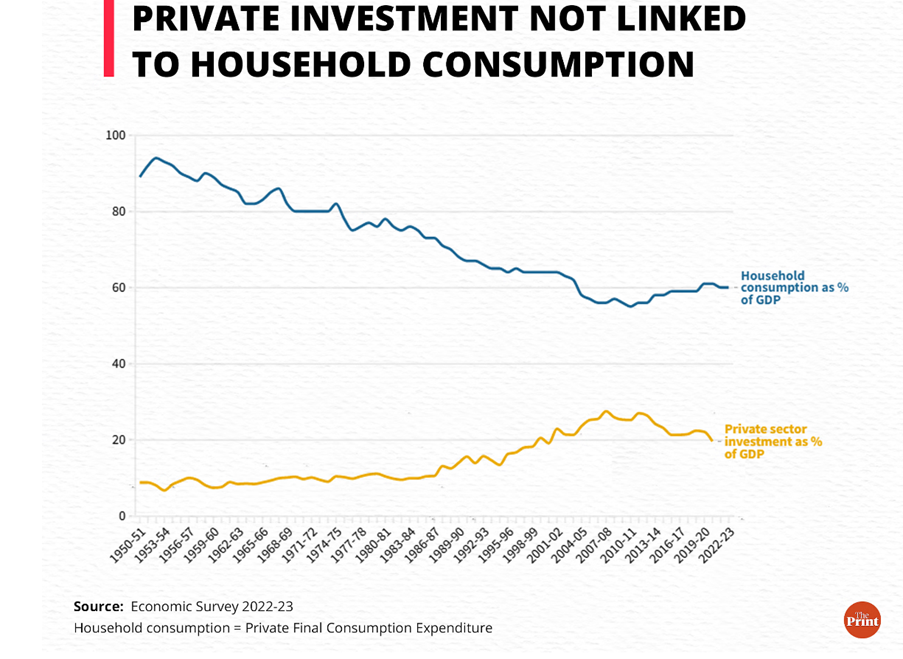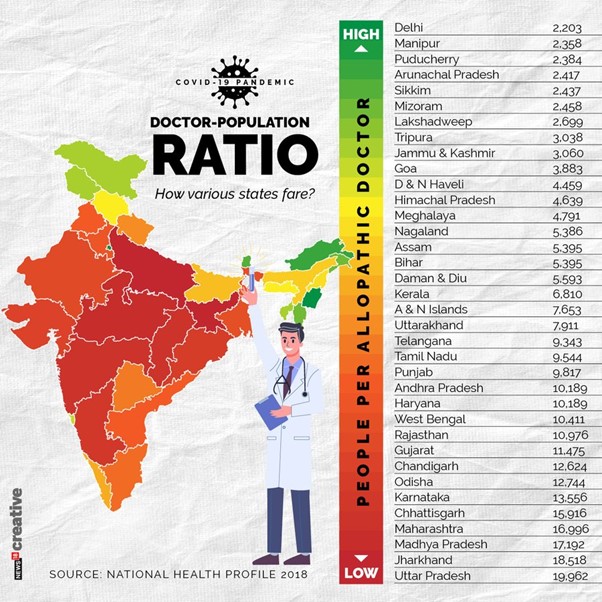CONTENTS
- Drop in Private Investments
- Centre-State Relations and Poor Doctor-Population Ratio
Drop in Private Investments
Context:
The narrative thus far revolves around the persistent challenge of sluggish private investment, measured by the proportion of private Gross Fixed Capital Formation (GFCF) to gross domestic product (GDP) at current prices, which has hindered the progress of the Indian economy. Private investment has steadily declined since 2011-12, prompting the government to pin hopes on major Indian corporations to step up their investment efforts. In a bid to stimulate private investment, the government slashed corporate taxes from 30% to 22% in 2019.
Relevance:
GS3-
- Mobilization of Resources
- Growth
- Development
- Inclusive Growth and issues arising from it
Mains Question:
What is meant by the private Gross Fixed Capital Formation? Also discuss that how do government policies affect private capital formation. (10 Marks, 150 Words).
Gross Fixed Capital Formation:
- GFCF, or Gross Fixed Capital Formation, signifies the expansion of fixed capital within an economy. Fixed capital encompasses assets like buildings and machinery that require investment for their creation.
- Therefore, private GFCF serves as a rough gauge of the private sector’s willingness to invest. Additionally, overall GFCF includes capital formation resulting from government investment.
- The significance of GFCF lies in the fact that fixed capital enables workers to produce a greater quantity of goods and services annually, thereby fostering economic growth and enhancing living standards.
- Essentially, fixed capital largely determines an economy’s overall output and consequently influences what consumers can afford to purchase in the market.
- Developed economies like the U.S. typically boast higher levels of fixed capital per capita compared to developing economies like India.
Trajectory of Private Investment in India:
- Following the economic reforms of the late 1980s and early 1990s, which bolstered private sector confidence, private investment in India witnessed significant growth.
- Prior to economic liberalization, spanning from independence to the initiation of reforms, private investment hovered around or slightly above 10% of the GDP.
- In contrast, public investment as a share of GDP steadily increased over the decades, starting from less than 3% of GDP in 1950-51, eventually surpassing private investment as a percentage of GDP in the early 1980s.
- However, post-liberalization, public investment declined, while private investment assumed a leading role in fixed capital formation.
- The surge in private investment endured until the global financial crisis of 2007-08. During this period, it escalated from approximately 10% of GDP in the 1980s to around 27% in 2007-08.
- However, beginning from 2011-12, private investment experienced a downturn, reaching a nadir of 19.6% of GDP in 2020-21.

Factors that have Led to the Decline in Private Investment:
- Many economists in India attribute the primary cause to low private consumption expenditure, especially in the past decade, exacerbated by the onset of the pandemic.
- According to their analysis, robust consumer spending is crucial to instilling confidence among businesses that there will be adequate demand for their products once they invest in building fixed capital.
- Therefore, these economists advocate for increased government spending to stimulate consumption expenditure and, consequently, ignite private investment.
- However, historical trends in India suggest that an uptick in private consumption hasn’t necessarily translated into increased private investment.
- Surprisingly, a decrease in consumer spending has sometimes spurred private investment rather than hindering it.
- Over the years, private final consumption expenditure gradually declined from nearly 90% of GDP in 1950-51 to a low of 54.7% of GDP in 2010-11, which preceded a peak in private investment followed by a prolonged decline.
Private Investment vis-à-vis Private Consumption:
- Since 2011-12, private consumption has increased while private investment has experienced a concerning decline as a proportion of GDP.
- This inverse relationship between consumption and investment likely arises from the fact that funds allocated towards savings and investment, whether by the government or private entities, often come at the expense of reduced consumption expenditure.
- Another school of thought among economists posits that structural issues may underlie the significant drop in private investment as a percentage of GDP over the past decade or so.
- They point to unfavorable government policies and policy uncertainty as key factors affecting private investment. The upsurge in private investment during the 1990s and 2000s coincided with the initiation of economic reforms in 1991.
- Conversely, the downturn in private investment correlates with the deceleration in the pace of reforms over the past two decades under both the UPA (second term) and NDA governments.
- Moreover, policy uncertainty can deter private investment as investors seek stability to undertake risky long-term projects.

Conclusion:
Low Private Investment could lead to a deceleration in economic growth, as a robust fixed capital base is essential for enhancing economic output. Some view the government’s efforts to boost public investment as detrimental, arguing that it crowds out private investment. However, others argue that government investment serves as a necessary complement to offset the shortfall in private investment.
Centre-State Relations and Poor Doctor-Population Ratio
Context:
The intricate details of execution can often thwart even the grandest aspirations. Few examples illustrate this as poignantly as the saga of the Madurai AIIMS. The concept of establishing numerous All India Institute of Medical Sciences (AIIMS) throughout the nation stemmed from a pressing need — to address the disparity between healthcare demand and availability in India, and rectify the glaringly inadequate doctor-to-patient ratio.
Relevance:
GS2-
- Cooperative Federalism
- Health
Mains Question:
What are the challenges faced by the medical education ecosystem in India? In the context of recent events at Madurai AIIMS, analyse how centre-state relations have an effect in the functioning of these institutions. (15 Marks, 250 Words).
Troubling Centre-State Relations:
- In 2003, the central government introduced the Pradhan Mantri Swasthya Suraksha Yojana (PMSSY) with precisely this objective in mind.
- The Pradhan Mantri Swasthya Suraksha Yojana (PMSSY) was unveiled in 2003 with the aim of rectifying regional disparities in the accessibility of cost-effective and dependable tertiary healthcare services, as well as enhancing infrastructure for top-notch medical education nationwide.
- The Ministry of Health and Family Welfare is entrusted with the oversight and management of the PMSSY.
Dual Components:
The PMSSY consists of two primary components:
- Establishment of institutions akin to AIIMS.
- Enhancement of existing government medical colleges across various states.
Cost Sharing:
- The financial burden for upgrading each medical college institution is distributed between the Central government and the respective state government.
- However, it wasn’t until 2006 that the PMSSY was set in motion, leading to the establishment of six AIIMS-like medical institutions across the country.
- Presently, there are 20 operational AIIMS institutions with fully functional medical colleges, while three more are in various stages of development.
- Undoubtedly, these institutions have opened up abundant opportunities for aspiring students and propelled the mission of extending affordable healthcare education beyond metropolitan areas. However, the ambitions have often outpaced the execution.
- At AIIMS Madurai, a project that has further strained relations between the central and state governments, persistent grievances revolve around insufficient infrastructure, amenities, and staffing shortages.
- Despite being touted as a ‘prestigious’ endeavor by the Central government, the Indian Prime Minister laid the foundation stone for construction in Thoppur, Madurai, in January 2019.
- Despite the absence of even basic facilities such as a building, the administration, undeterred, began accepting student applications from 2021.
- However, construction work remains incomplete, and to accommodate students, three successive batches of undergraduates have been directed to the Government Medical College and Hospital in the nearby Ramanathapuram district.
- Recently, these students initiated protests, highlighting a stark disparity between the expectations of an AIIMS institution and the reality of their experience in Madurai. This gap extends not only to infrastructure but also to the level of exposure to patients.
- The prolonged delay in the construction of AIIMS became a contentious topic during the 2021 Assembly elections in Tamil Nadu. A Minister highlighted the minimal progress by pointing out a solitary brick as the extent of construction activity at the site.
- Despite assurances that the project would soon be completed and students relocated to Madurai, the sluggish implementation has already impacted 150 students.
- Meanwhile, the fundamental issue prompting the establishment of AIIMS remains unresolved. Official statistics reveal a concerning doctor-population ratio in the country, standing at 1:834, with rural areas facing even greater shortages.

- The latest Rural Health Statistics report underscores a severe deficiency of specialist doctors at Community Health Centers (CHCs) across India, with nearly 80% of the required specialists absent.
- This shortage encompasses various medical disciplines, including surgeons (83.2%), obstetricians and gynaecologists (74.2%), physicians (79.1%), and paediatricians (81.6%).
- Over the years, there has been a notable increase in the number of specialist doctors at CHCs, rising by 25% from 3,550 in 2005 to 4,485 in 2022. However, this growth has not kept pace with the escalating demand for specialist services, resulting in a significant disparity.
- Moreover, alongside the shortage of specialist doctors, there is also a dearth of female health workers and auxiliary nursing midwives at Primary Health Centers (PHCs) and sub-centers, with up to 14.4% of these positions remaining unfilled.
Other Relevant Concerns with Medical Education in India:
Limited Seats:
The number of available seats in medical colleges continues to fall short of the growing number of aspiring medical professionals, with a ratio of approximately 20 aspirants for every seat.
Rising Aspirants:
A study conducted by the National Institute of Educational Planning indicates a nearly threefold increase in the number of students taking medical entrance exams over the past decade, yet only a mere 0.25% secure admission to premier institutions.
Uneven Distribution:
The concentration of medical colleges in urban areas exacerbates the scarcity of medical facilities in rural regions, perpetuating a significant disparity in access to healthcare education.
High Private College Fees:
Government-run institutions offer more affordable tuition fees and uphold superior educational standards compared to their private counterparts.
Outdated Curriculum:
Many medical colleges in India adhere to outdated curricula that fail to align with contemporary medical practices, leading to a gap between theoretical knowledge and practical clinical skills.
Lack of Infrastructure:
A significant number of medical colleges lack essential infrastructure such as modern laboratories, advanced medical equipment, and access to cutting-edge technology, compromising the quality of medical education.
Inadequate Practical Training:
The predominant focus on theoretical instruction in medical education neglects the importance of hands-on practical training, resulting in graduates with insufficient clinical experience.
Limited Research Focus:
Medical research receives inadequate attention in India compared to developed nations, as many doctors prioritize employment over research pursuits after completing their education, leading to a dearth of innovative medical research initiatives.
Conclusion:
It is imperative for both the Central and State governments to collaborate effectively to ensure that these medical institutions deliver high-quality education and that students are not victimized due to bureaucratic delays and federal relations.





